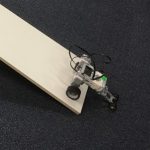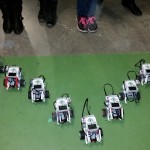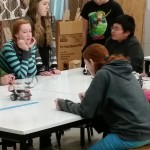This classic challenge is a great introductory activity. It works well with a standard Driving Base, such as the EV3 Robot Educator Mode or an equivalent quick build, and the programming is relatively straight forward. Its main strength, however, is in having the entire class work together to solve a challenge collaboratively.

The challenge
Work together as a class to make all the robots perform a synchronised dance.
Equipment requirement
Although it’s not absolutely necessary, I would recommend having everyone build the same robot, such as the SPIKE Prime Driving Base (external link) or the EV3 Robot Educator Model Driving Base (external link), prior to starting this challenge. I usually give the fastest builders something like the Figure 8 challenge to keep them occupied while we’re waiting for the rest of the class to catch up.
You will also need a reasonable amount of floor space to line up the robots with space in between.
Teacher notes
I normally frame this challenge by showing the class an example of another dance, such as the following video, and break it down into parts (much like the approach taken by Ian Chow-Miller as described in this post).
Some of the highlights of my teaching career have come from the Wave challenge. One that is is nicely captured in the following video clip was the very first time I ran it. I’ve known of this challenge for a long time, but after years of choosing not to run it because I felt it was too simplistic, I had a class that I felt needed a push to collaborate more. In particular, I wanted to see them being more prepared to share ideas and help each other. I gave them this challenge and it worked so well that I have used with my classes every year since. Check out the sense of accomplishment displayed in the following video. And this was just from them getting the first part of the challenge working.
Another highlight came when I introduced the challenge to a new class a couple of years later. I had all the students line up their robots and gather around as I explained the overall challenge. I asked them to start by doing the “wedge” formation. That is, I wanted the robots to start in a line, then move into a wedge shape, and then back to the starting line, finishing their movement at the same time. I was very cafeful to explain where and when I wanted the robots to be at the start, middle, and finish, but not how I wanted them to get there. I didn’t mention anything about considerations of speed versus time, for example. I told them they would have to organise themselves and stepped back out of the discussions that broke out. Within seconds, I had students grab whiteboards markers and start writing out pseduocode and charts of where the robots would be. Some students discussed how the robots would need to be positioned on the starting line for consistent performance, and another coordinated the countdown for starting the robots. After each run, it was immediately obvious which robots needed to be adjusted, and before long they had completed the first part of the challenge without any intervention from me.
And then after successfully completing this first task of the challenge, one student asked the group, “Okay, we’ve got 10 minutes until the break, so what are we going to do now?” “How about we do it again but with the them moving the other way?” “Yeah, I reckon we can do that,” and they did! I’ve never had so little to do as a teacher, and this didn’t go unnoticed by the students. Just as they headed off to add the extra maneuvre to their robots, one student said to me in jest, “You know, we don’t need you!”
See also
Rob Torok
Latest posts by Rob Torok (see all)
- Obstacle Course - 26 August 2020
- Crash Test Dummy - 26 August 2020
- The Wave - 21 May 2020
- Build X - 20 May 2020
- Build a Duck - 20 May 2020


